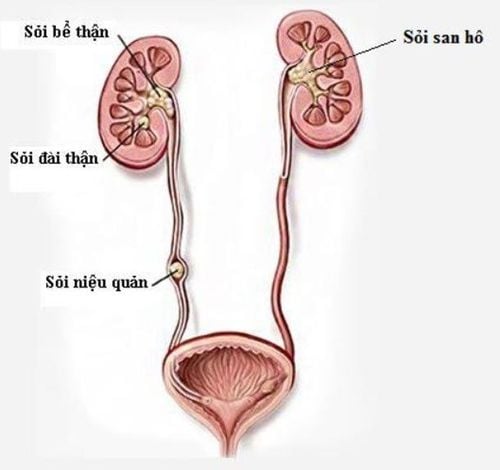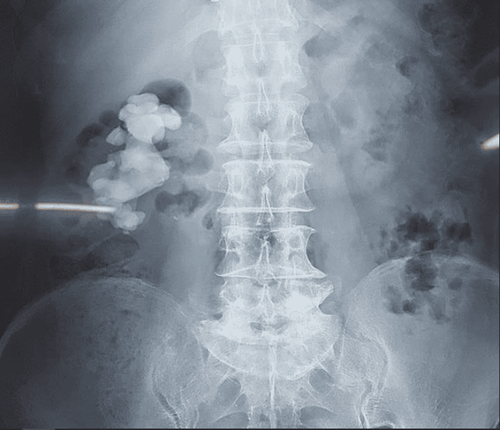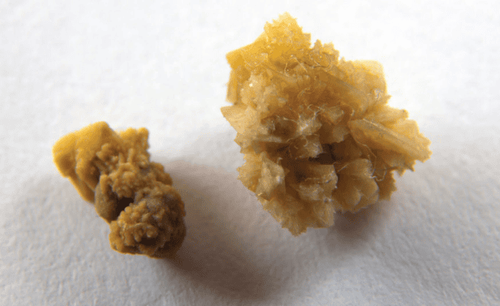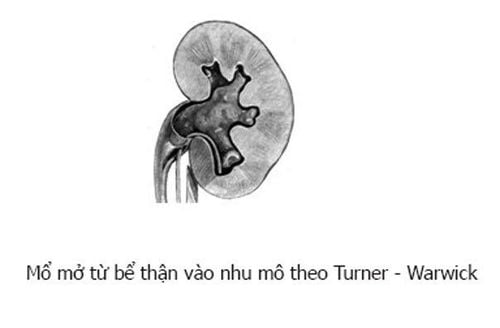This is an automatically translated article.
Coral kidney stones are stones filled with 2 or more calyx branches, shaped like coral. Coral kidney stones are also known as struvite or infectious stones. Coral kidney stones if not treated can cause pyelonephritis, kidney failure, systemic toxicity, which leads to death.
1. What are coral kidney stones?
Coral kidney stones are stones filled with 2 or more calyx branches, shaped like coral. Coral kidney stones are also known as struvite or infectious stones. The characteristic of coral kidney stones is that the stones are only in the calyx of the renal pelvis, not in other locations such as the bladder or ureters. Coral kidney stones if not treated can cause pyelonephritis, kidney failure, systemic toxicity, which leads to death.

Vị trí sỏi thận san hô
2. Why open surgery for coral stones?
Depending on how damaged the kidneys are, the doctor will choose the appropriate treatment. Coral kidney stones often completely destroy kidney function, so nephrectomy to remove coral stones is the best treatment and has a low recurrence rate.
Open surgery for coral stones has been widely used in the past. Today, with the development of science and technology in the medical field, kidney stone patients can be treated by other less traumatic methods such as lithotripsy outside the body or taking stones through the skin, using drugs. , ... These methods are also suitable when the renal function is preserved.
However, open surgery for coral stones is still applied in the following cases:
Large kidney stones, stones cast according to the renal pelvis such as coral stones. The patient is not able to be treated with other less traumatic methods. Patients experience failure after other less traumatic treatments have failed. Solve the complications and complications encountered when treating with less traumatic methods. Medical treatment can cause severe infection and kidney failure that can lead to death. Coral stones have caused severe decline in kidney function.

Hình ảnh Xquang sỏi thận san hô
3. Open surgery to treat coral kidney stones
3.1 Open surgical paths for coral stones First, to choose an open surgical path for coral stones on the kidney, it should be based on the following principles:
Features of the kidney: Location of the renal pelvis ( inside or outside the sinus); the width of the renal hilum (wide or narrow); distribution and relationship of renal artery and renal vein with renal hilum, renal pelvis; malformation. Characteristics of stones: Location of kidney stones (renal pelvis, calyces); size; quantity. The degree and condition of kidney stone damage caused: pyelonephritis, renal parenchyma, renal peduncle. Renal function. Age, sex, and comorbidities of the patient. The following are open surgical routes for nephrolithiasis:
Intrasinal pyeloplasty, lifting the renal hilum according to Gil-Vernet: When the renal pelvis is exposed, use 2 eyelid valves to open up the blood vessels. and renal navel. When the renal pelvis is seen in the sinus and part of the great calyx canal is seen, an incision is made on the posterior surface (also anteriorly) of the renal pelvis in a V-shape (distance from the top of the V to the junction of the ureter and the renal pelvis). several millimeters). Of the two branches of the V, one is directed to the superior and inferior calyx of the renal pelvis, the other possibly located on the lower surface of the renal pelvis. The advantages of open surgery for pyelonephritis in the sinus with renal umbilicus are that it allows to remove some coral stones with less complexity, the rate of complications and complications when opening the renal pelvis as well as other cases. parenchymal incision is reduced, thereby helping to limit renal pelvis tear. This method is only done for cases where the renal pelvis and hilum are not too narrow, there is no inflammation around the pyelonephritis, and the patient has had surgery for the first time.

Sỏi thận san được lấy ra ngoài
Longitudinal parenchymal open surgery (no more than 2/3 of the length of the kidney, do not use hypothermia): When the kidney is exposed, temporarily clamp the renal artery and make a longitudinal incision of the renal parenchyma, Incision is made along and behind the convex edge of the kidney about 1cm, not more than 2/3 of the length of the kidney, do not touch the 2 poles, in rare cases, only 1 pole can be opened. The advantage of open surgery for coral stones by the renal parenchyma is to remove large coral stones, because it allows the calyx and renal pelvis to expose widely, allowing the whole to be examined, without causing atrophy of the renal poles. However, the disadvantage is that the opening line crosses many renal parenchyma as well as renal blood vessels, thus, causing morphological changes of the kidney. Open the kidney parenchyma horizontally, spokes: The arteries in the kidney are gradually divided outward, looking like the spokes of a wheel. Using the renal hilum as the axis, the opening of the kidney parenchyma is horizontal, spoke-shaped, causing less damage to the large blood vessels of the kidney. However, open surgery to treat coral kidney stones requires a combination of renal parenchymal surgery and prolonged surgery from the renal pelvis to the parenchyma to remove coral stones. Open surgery from the renal pelvis to the parenchyma according to Turner - Warwick: From the incision in the lower border of the renal pelvis, the opening is extended to the parenchyma in the lower pole inner margin on a curved iron tube used to remove stones. After the stones are removed, the renal pelvis is sutured closed. The advantage of this opening is that it allows to get a variety of stones, easy to stop bleeding, no need to clamp the renal peduncle. However, this route of open surgery for coral stones can cause major bleeding, leading to anemia and necrosis of the lower pole, causing urinary leakage.

Mổ mở theo Turner - Warwick
3.2 Measures to reduce stone residual in open surgery to treat coral kidney stones The principle in open surgery to treat coral kidney stones is to reduce the rate of stone remnants because residual stones in surgery will cause complications. dangerous such as urinary tract infections, urine leakage, recurrent stones. In order to limit the number of stones left in surgery, it is possible to apply techniques during surgery such as X-ray, endoscopy, ultrasound, inspecting stones with instruments, ...
Open surgery to treat kidney stones Respiration is a good choice, allowing large stones to be removed, limiting residual stones that cause complications after treatment.
To register for examination and treatment at Vinmec International General Hospital, you can contact Vinmec Health System nationwide, or register online HERE.
Recommended video:
What should people with kidney stones eat?
MORE:
Surgery to remove the "burden" of kidney stones, worn for more than 10 years What you need to know about kidney stone disease Successfully performed endoscopic percutaneous large kidney stone lithotripsy













